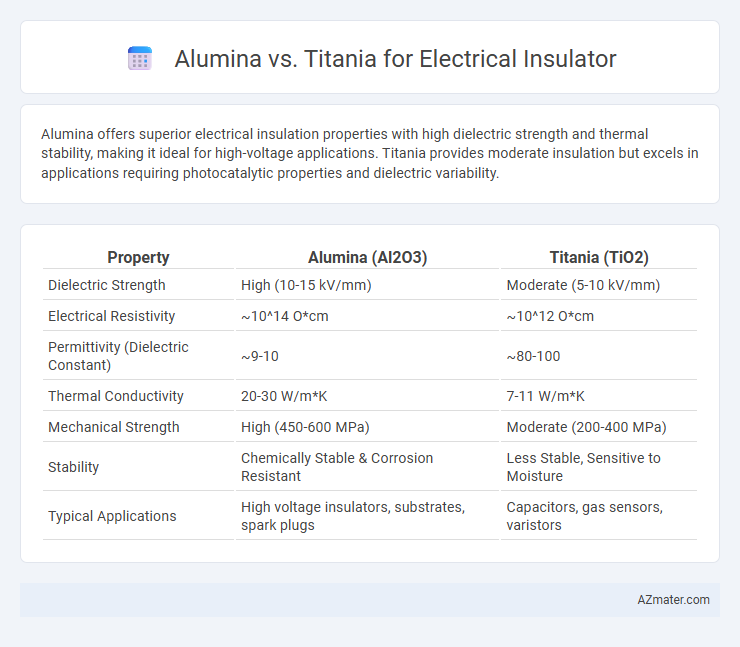Alumina offers superior electrical insulation properties with high dielectric strength and thermal stability, making it ideal for high-voltage applications. Titania provides moderate insulation but excels in applications requiring photocatalytic properties and dielectric variability.
Table of Comparison
| Property | Alumina (Al2O3) | Titania (TiO2) |
|---|---|---|
| Dielectric Strength | High (10-15 kV/mm) | Moderate (5-10 kV/mm) |
| Electrical Resistivity | ~10^14 O*cm | ~10^12 O*cm |
| Permittivity (Dielectric Constant) | ~9-10 | ~80-100 |
| Thermal Conductivity | 20-30 W/m*K | 7-11 W/m*K |
| Mechanical Strength | High (450-600 MPa) | Moderate (200-400 MPa) |
| Stability | Chemically Stable & Corrosion Resistant | Less Stable, Sensitive to Moisture |
| Typical Applications | High voltage insulators, substrates, spark plugs | Capacitors, gas sensors, varistors |
Introduction: Alumina vs Titania as Electrical Insulators
Alumina (Al2O3) and Titania (TiO2) are widely used ceramic materials in electrical insulation due to their excellent dielectric properties and thermal stability. Alumina offers high electrical resistivity, superior thermal conductivity, and mechanical strength, making it ideal for high-voltage applications. Titania, while exhibiting good dielectric constant and breakdown voltage, often finds niche use where enhanced dielectric permittivity is required but typically has lower thermal conductivity compared to alumina.
Material Composition and Structure
Alumina (Al2O3) is a ceramic material characterized by its dense, crystalline structure composed primarily of aluminum and oxygen atoms, offering excellent electrical insulation due to its high dielectric strength and low electrical conductivity. Titania (TiO2), while also a ceramic, consists of titanium and oxygen in a rutile or anatase crystal form, providing moderate electrical insulation but with higher dielectric constant and slightly increased conductivity compared to alumina. The intrinsic material composition and microstructural differences make alumina superior for high-voltage insulator applications where thermal stability and minimal electrical loss are critical.
Electrical Insulation Properties
Alumina exhibits superior electrical insulation properties due to its high dielectric strength, low dielectric loss, and excellent thermal conductivity, making it ideal for high-voltage applications. Titania, while possessing good dielectric constant values, typically shows lower resistivity and higher dielectric losses, limiting its efficiency as an electrical insulator. The stable chemical structure and high purity of alumina contribute to its widespread use in insulators, transformers, and electronic substrates.
Dielectric Strength Comparison
Alumina (Al2O3) exhibits a high dielectric strength typically around 10-15 kV/mm, making it an excellent electrical insulator for high-voltage applications. Titania (TiO2), while also a good insulator, generally has a lower dielectric strength ranging between 5-10 kV/mm, which limits its use in extreme voltage environments. The superior dielectric strength of alumina ensures better resistance to electrical breakdown, enhancing reliability in insulating components.
Thermal Conductivity and Stability
Alumina offers superior thermal conductivity ranging from 25 to 30 W/mK, making it highly effective for dissipating heat in electrical insulators, while titania typically exhibits lower thermal conductivity around 11 W/mK. Alumina's stability under high temperatures and oxidative environments surpasses titania, maintaining structural integrity up to 1700degC compared to titania's lower thermal stability near 1200degC. These properties make alumina the preferred choice for high-performance electrical insulation requiring efficient heat dissipation and long-term thermal stability.
Mechanical Properties and Durability
Alumina exhibits superior mechanical strength and hardness compared to Titania, making it more resistant to wear and deformation under stress, which enhances its durability as an electrical insulator. Titania offers good toughness but lower hardness and strength, limiting its long-term mechanical performance in high-stress insulation applications. Alumina's higher thermal stability and corrosion resistance contribute to prolonged service life in harsh electrical environments.
Resistance to Environmental Factors
Alumina excels as an electrical insulator due to its superior resistance to moisture, chemical corrosion, and thermal shock, maintaining stable dielectric properties under harsh environmental conditions. Titania offers good insulating capabilities but is more susceptible to moisture absorption and chemical degradation, which can compromise its long-term performance in outdoor or industrial settings. Alumina's high density and strong chemical inertness make it the preferred choice for applications requiring durable insulation against environmental stressors.
Common Applications in Electrical Systems
Alumina (Al2O3) is widely used as an electrical insulator in high-voltage equipment such as transformers, circuit breakers, and insulator bushings due to its excellent dielectric strength and thermal conductivity. Titania (TiO2), while less common, is utilized in specialized applications requiring high permittivity, including capacitor dielectrics and varistors, benefiting from its semiconductor properties. Both materials contribute to enhancing electrical system performance, with alumina preferred for mechanical durability and thermal stability, and titania valued for its unique electrical characteristics.
Cost and Manufacturing Considerations
Alumina offers a cost-effective solution for electrical insulators due to its abundant availability and established manufacturing processes, resulting in lower production expenses compared to titania. Titania, while providing superior dielectric strength and higher temperature resistance, incurs higher costs due to complex synthesis methods and raw material scarcity. Manufacturing alumina insulators benefits from well-developed ceramic processing techniques, whereas titania requires specialized handling and sintering conditions, increasing overall production complexity and cost.
Summary and Material Selection Guidelines
Alumina offers exceptional electrical insulation properties with a high dielectric strength of approximately 10-15 kV/mm, excellent thermal conductivity around 25-30 W/m*K, and strong mechanical strength, making it ideal for high-voltage and high-temperature applications. Titania provides moderate dielectric strength near 5-8 kV/mm but has superior dielectric constant, enhancing capacitance in specific applications, though its thermal conductivity and mechanical durability are lower than alumina. Material selection should prioritize alumina for robust, high-voltage insulation needs, while titania suits applications requiring higher permittivity and moderate insulation performance.

Infographic: Alumina vs Titania for Electrical insulator
 azmater.com
azmater.com